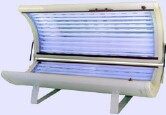
THURSDAY, May 27 (HealthDay News) — People who use tanning beds to keep that year-round glow are dramatically increasing their risk for developing melanoma, the deadliest of skin cancers, a new study finds.
In fact, the more you tan and the longer you tan, the more the risk increases, researchers noted.
“We found the risk of melanoma was 74 percent higher in persons who tanned indoors than in persons who had not,” said lead researcher DeAnn Lazovich, an associate professor at the division of epidemiology and community health at the University of Minnesota.
“We also found that people who tanned indoors a lot were 2.5 to 3 times more likely to develop melanoma than people who had never tanned indoors,” she added. In the context of the study, “a lot” of indoor tanning meant a total of at least 50 hours of tanning bed exposure, or more than 100 sessions, or at least 10 years of regular tanning bed use.
The report is published in the May 27 issue of Cancer Epidemiology, Biomarkers & Prevention.
For the study, Lazovich’s team collected data on melanoma cases in Minnesota from 2004 through 2007. The researchers also conducted interviews and had patients complete questionnaires about indoor tanning, including the devices used, when the person began tanning and for how long.
The researchers found that among 1,167 people with melanoma, almost two-thirds (63 percent) had used tanning beds. Among those who used tanning beds, the risk for developing melanoma rose 74 percent, Lazovich’s group found.
The risk for melanoma was significant whether the tanning beds used both UVA and UVB rays or UVA rays only. For beds using UVA rays, the risk of melanoma was increased 4.4-fold.
“What is remarkable about our results are that they are very consistent,” Lazovich said. “We found these relationships whether we looked at it by age, by gender, by where the tumor was found or by how we measured how much people tanned or what kind of devices they used.”
Lazovich noted that the danger is particularly acute among young women who seem to have a predilection for indoor tanning.
“Indoor tanning is an underappreciated problem, especially among young women. More young women tan indoors than smoke cigarettes, and melanoma is the second most common cancer diagnosed in young women,” she said. “And there is evidence that the incidence of melanoma is increasing in young women. It’s time to pay a little more attention to this as a risk factor that is avoidable.”
In March, an advisory panel to the U.S Food and Drug Administration recommended that the agency add bolder warning labels to tanning beds, change how they are regulated by the FDA and require parental consent for users aged 18 and under. At the time, panelist Dr. Gary Olding added that, “given the absence of any demonstrated benefit, I think it’s an obligation for us to ban artificial tanning for those under 18.”
The new data seems to fuel the debate.
Dr. Allan Halpern, vice president of the Skin Cancer Foundation and chief of dermatology service at Memorial Sloan-Kettering Cancer Center in New York City, said that, “together with the recently published extended follow-up of a large Norwegian-Swedish cohort, these data strongly support the conclusions of the International Agency for Research on Cancer that artificial UV tanning devices are carcinogenic in humans.”
“We hope that these findings, along with what we already know about the risks of indoor tanning, will keep people from using tanning beds. We also hope this additional data will motivate the FDA to expedite appropriate regulation of these devices,” Halpern said.
But the industry takes a different view.
John Overstreet, spokesman for the Indoor Tanning Association, said that “the latest science is contradictory. A study out just two weeks ago from the M.D. Anderson Cancer Center found that UVA light does not cause melanoma.”
And, a number of other studies and experts also tout the cancer-fighting benefits of vitamin D, which is produced by the skin via moderate UV light exposure, he said.
“So clearly, lots of studies are reaching far different conclusions,” Overstreet said. “These other findings may not be promoted to the media as actively as those who may have a specific agenda, but they show that science is still wrestling with this issue and there’s certainly still more to learn. We welcome a more complete body of research that will allow us to advise our customers on how to achieve their goals without unnecessary risk of overexposure.”
More information
For more on skin cancer, visit the American Cancer Society.

